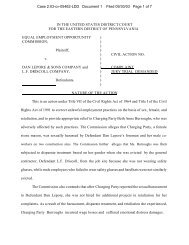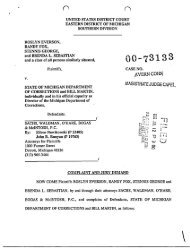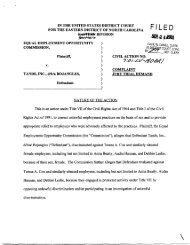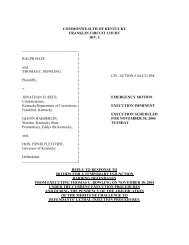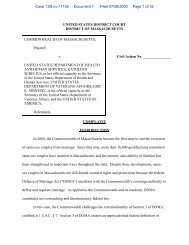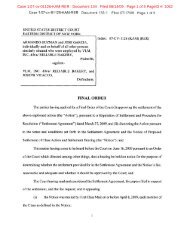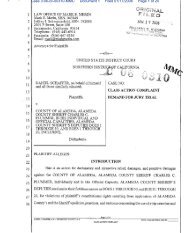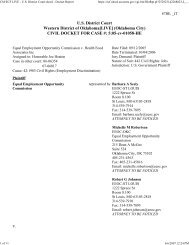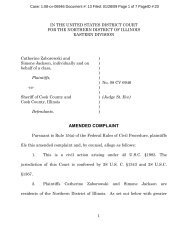White v. Johnson - Plaintiff's Memorandum of Law ... - Clearinghouse
White v. Johnson - Plaintiff's Memorandum of Law ... - Clearinghouse
White v. Johnson - Plaintiff's Memorandum of Law ... - Clearinghouse
You also want an ePaper? Increase the reach of your titles
YUMPU automatically turns print PDFs into web optimized ePapers that Google loves.
Melvin Wayne <strong>White</strong>,<br />
Plaintiff,<br />
v.<br />
Gary <strong>Johnson</strong>,<br />
Executive Director,<br />
Texas Department <strong>of</strong> Criminal Justice,<br />
Doug Dretke<br />
Director, Correctional Institutions Division<br />
Texas Department <strong>of</strong> Criminal Justice,<br />
Charles O'Reilly,<br />
Senior Warden, Huntsville Unit<br />
Huntsville, Texas,<br />
and,<br />
Unknown Executioners;<br />
Defendants.<br />
I'<br />
UNITED STATES DISTRICT COURT<br />
SOUTHERN DISTRICT OF TEXAS<br />
HOUSTON DIVISION<br />
PLAINTIFF'S MEMORANDUM OF LAW<br />
IN SUPPORT OF COMPLAINT<br />
)<br />
)<br />
)<br />
)<br />
)<br />
)<br />
)<br />
)<br />
)<br />
)<br />
)<br />
)<br />
)<br />
)<br />
)<br />
)<br />
)<br />
)<br />
)<br />
)<br />
)<br />
)<br />
)<br />
No. ____ _<br />
(death-penalty case)<br />
Plaintiff seeks relief under 42 U.S.C. § 1983 from violations by state actors <strong>of</strong> rights<br />
secured by the United States Constitution. Plaintiff requests relief from two threatened injuries<br />
by defendants. First, plaintiff requests that this Court enter a permanent injunction prohibiting<br />
defendants from injecting him with three chemicals that (1) unnecessarily increase the risk <strong>of</strong><br />
torture during the execution; and (2) are superfluous and wholly unnecessary to effect lethal<br />
injection. Second, plaintiff requests that this Court enter an injunction prohibiting defendants<br />
1
from utilizing any invasive medical procedures to gain venous access for the lethal injection, at<br />
least until and unless plaintiff is made aware under what circumstances and standards those<br />
procedures will occur and those standards are sufficient to protect plaintiff's medical needs.<br />
This <strong>Memorandum</strong> proceeds in three parts. In Part I, plaintiff establishes his first claim<br />
that the defendants are acting with deliberate indifference in unnecessarily increasing the risk<br />
plaintiff will experience torture during the administration <strong>of</strong> his death sentence by injecting him<br />
with wholly unnecessary drugs, in violation <strong>of</strong> his Eighth and Fourteenth Amendment rights to<br />
remain free from cruel and unusual punishment. In Part II, plaintiff shows that the violation<br />
outlined by his first claim may be redressed under 42 U.S.C. § 1983 and that he is entitled to the<br />
equitable relief sought. In Part III, plaintiff establishes that the defendants are acting with<br />
deliberate indifference to his medical needs by failing to provide any protocol for gaining venous<br />
access and by potentially resorting to an invasive medical procedures to gain venous access<br />
without adequate safeguards, also in violation <strong>of</strong> plaintiff's Eighth and Fourteenth Amendment<br />
rights to remain free from cruel and unusual punishment.<br />
I. LETHAL INJECTION, AS DEFENDANTS ADMINISTER IT IN TEXAS, POSES<br />
AN INTOLERABLE AND FORESEEABLE RISK OF CAUSING<br />
UNNECESSARY PAIN, TORTURE, AND LINGERING DEATH, IN VIOLATION<br />
OF THE EIGHTH AMENDMENT.<br />
The Eighth Amendment's proscription against cruel and unusual punishment forbids the<br />
infliction <strong>of</strong> unnecessary pain in the execution <strong>of</strong> a sentence <strong>of</strong> death. Louisiana ex reI. Francis<br />
v. Resweber, 329 U.S. 459, 463 (1947) (opinion <strong>of</strong> Reed, J.); Fierro v. Gomez, 865 F. Supp.<br />
1387, 1413 (N.D. Cal. 1994) (execution by lethal gas in California held unconstitutional where<br />
evidence indicated "death by this method is not instantaneous. Death is not extremely rapid or<br />
within a matter <strong>of</strong> seconds. Rather ... inmates are likely to be conscious for anywhere from<br />
2
fifteen seconds to one minute from the time that the gas strikes their face" and "during this<br />
period <strong>of</strong> consciousness, the condemned inmate is likely to suffer intense physical pain" from<br />
"air hunger"; "symptoms <strong>of</strong> air hunger include intense chest pains ... acute anxiety, and<br />
_ struggling to breath"), aff'd, 77 F.3d 301, 308 (9th Cir. 1996), vacate.d on other grounds, 519<br />
u.s. 918 (1996). Further, "[p]unishments are cruel when they involve ... a lingering death." In<br />
re Kemmler, 136 U.S. 436,447 (1890). A punishment is particularly constitutionally <strong>of</strong>fensive if<br />
it involves theforeseeable infliction <strong>of</strong> suffering. Furman v. Georgia, 408 U.S. 238, 273 (1973),<br />
citing Resweber, supra (had failed execution been intentional and not unforeseen, punishment<br />
would have been, like torture, "so degrading and indecent as to amount to a refusal to accord the<br />
criminal human status"). Due to the anticipated chemicals defendants intend to inject in plaintiff,<br />
it is not only foreseeable but also predictable that unnecessary pain, torture, and lingering death<br />
will result. The deliberate indifference to this risk <strong>of</strong> unnecessary pain violates plaintiff s Eighth<br />
Amendment rights.<br />
A. The combination <strong>of</strong> chemicals defendants intend to use to execute plaintiff<br />
creates an intolerable risk <strong>of</strong> unnecessary suffering and torture.<br />
It is anticipated that defendants intend to carry out plaintiff s lethal injection by injecting<br />
him with a combination <strong>of</strong> three chemical substances: sodium thiopental, or sodium pentothal (an<br />
ultrashort-acting barbiturate); pancuroniurn bromide, or Pavulon (a curare-derived agent which<br />
paralyzes all skeletal or voluntary muscles, but which has no effect whatsoever on awareness,<br />
cognition or sensation); and potassium chloride (an extraordinarily painful chemical which<br />
activates the nerve fibers lining the inmate's veins and which can interfere with the rhythmic<br />
contractions <strong>of</strong> the heart and cause cardiac arrest). Each <strong>of</strong> these chemicals individually is<br />
wholly unnecessary and creates intolerable risks in the administration <strong>of</strong> lethal injection; in<br />
3
combination, those risks are enhanced even further. The use <strong>of</strong> these chemicals, alone or<br />
together, cannot pass constitutional muster. Far from producing a rapid and sustained loss <strong>of</strong><br />
consciousness and humane death, this particular combination <strong>of</strong> chemicals may cause the inmate<br />
to consciously suffer an excruciatingly painful and pJotracted death.<br />
1. The assumed execution protocol.<br />
Plaintiff <strong>White</strong> does not know precisely how defendants will execute him by lethal<br />
injection, because defendants keep their lethal injection protocol a secret. See Exhibit 1 (Letter<br />
from James L. Hall to Alberta Phillips, Jan. 2, 2004). In a recent lawsuit, however, defendants<br />
provided to the Court in written pleadings a short description <strong>of</strong> the procedure:<br />
The process provides for three chemical agents to be administered as follows:<br />
first, two needles (one is a back -up) are inserted into each arm <strong>of</strong> the condemned<br />
inmate and connected to several intravenous drip bags containing a saline<br />
solution. Next, a lethal dose (3 grams) <strong>of</strong> sodium thiopental is given to sedate the<br />
inmate. Then, the intravenous tube is flushed with saline solution. Next,<br />
pancuronium bromide (20 milligrams) is administered to collapse the <strong>of</strong>fender's<br />
diaphragm and lungs. The intravenous tube is flushed again with saline solution.<br />
And finally, potassium chloride (70 milliliters) is administered to stop the<br />
<strong>of</strong>fender's heart.<br />
Defendants' Supplemental Response in Opposition to Request for Expedited Discovery, Aldrich<br />
v. <strong>Johnson</strong>, No. 04-2955 (S.D.Tex. 2004). It should be noted, however, that defendant's source<br />
<strong>of</strong> this information is a Houston Chronicle article and does not purport to be derived from the<br />
lethal injection protocol, if any, maintained by defendants themselves. Lise Olsen and Mike<br />
Tolson, 'Stakes are High' in Death Appeals, Hou. CHRON., Dec. 12, 2003, at AI. The<br />
Chronicle's source, in turn, is the Texas Department <strong>of</strong> Criminal Justice (TDCJ) and the Death<br />
Penalty Information Center. I It is unclear which facts are derived from which source, as well as<br />
The article defendants cited to asserts that the injection <strong>of</strong> the sodium thiopental takes 30 seconds, that <strong>of</strong> the<br />
pancuronium bromide 45 seconds, and that <strong>of</strong> the potassium chloride 30 seconds. Yet, according to a website<br />
4
whether the description <strong>of</strong> the procedure is even accurate. The above outlined process, if<br />
remotely accurate, is rife with problems that threaten to inflict unbearable, yet undetectable, pain<br />
during the lethal injection.<br />
a. So_dium thiopental.<br />
Sodium thiopental, or sodium pentothal, is a short-acting barbiturate that is ordinarily<br />
used to render a surgical patient unconscious for mere minutes, only in the induction phase <strong>of</strong><br />
anesthesia, specifically so that the patient may re-awaken and breathe on his own power if any<br />
complications arise in inserting a breathing tube pre-surgery. Dr. Mark Heath, Assistant<br />
Pr<strong>of</strong>essor <strong>of</strong> Clinical Anesthesia at Columbia University, submitted a declaration in connection<br />
with a Maryland case challenging the same combinatory use <strong>of</strong> chemicals as defendants use. Dr.<br />
Heath's declaration explained the surgical use <strong>of</strong> sodium thiopental:<br />
When anesthesiologists use sodium thiopental, we do so for the purposes <strong>of</strong><br />
temporarily anesthetizing patients for sufficient time to incubate the trachea and<br />
institute mechanical support <strong>of</strong> ventilation and respiration. Once this has been<br />
achieved, additional drugs are administered to maintain a "surgical depth" or<br />
"surgical plane" <strong>of</strong> anesthesia (i.e., a level <strong>of</strong> anesthesia deep enough to ensure<br />
that a surgical patient feels no pain and is unconscious for the duration <strong>of</strong> the<br />
surgical procedure). The medical utility <strong>of</strong> thiopental derives from its ultrashortacting<br />
properties: if unanticipated obstacles hinder or prevent successful<br />
incubation, patients will quickly regain consciousness and will resume ventilation<br />
and respiration on their own.<br />
Exhibit 2 (Declaration <strong>of</strong> Dr. Mark Heath, filed in Oken v. Sizer, et. aI., No. 24-C-004242, (Cir.<br />
Ct. BaIt. City 2004).<br />
Because <strong>of</strong> its brief duration, sodium thiopental may not provide a sedative effect<br />
throughout the entire lethal injection. Dr. Dennis Geiser, the chairman <strong>of</strong> the Department <strong>of</strong><br />
maintained by defendants, an inmate is usually pronounced dead seven minutes after the fIrst injection begins. See<br />
Death Row Facts, available at http://www.tdcj.state.tx.us/statldrowfacts.htm.<br />
5
large Animal Clinical Sciences at the College <strong>of</strong> Veterinary Medicine at the University <strong>of</strong><br />
Tennessee, has explained:<br />
Sodium thiopental is not a proper anesthetic for use in lethal injection. Indeed,<br />
the American Veterinary Medical Association standards for euthanasia indicate<br />
that the ideal barbituric acid derivative for animal. euthanasia should be potent,<br />
long acting, stable in solution, and inexpensive. Sodium pentobarbital (not<br />
sodium thiopental) best fits these criteria. Sodium thiopental is a potent barbituric<br />
acid derivative but very short acting with one therapeutic dose.<br />
Exhibit 3 (Affidavit <strong>of</strong> Dr. Dennis Geiser, in the case <strong>of</strong> Texas v. Jesus Flores, No. 877,994A).<br />
Due to the chemical combination defendants are anticipated to use, there is also a<br />
probability that the second chemical, pancuronium bromide, will neutralize the short sedative<br />
effect <strong>of</strong>the sodium thiopental. Dr. Mark Heath stated:<br />
Exhibit 2.<br />
Sodium thiopental is an ultrashort-acting barbiturate that if administered in<br />
inadequate dosage begins to wear <strong>of</strong>f almost immediately.... Sodium Thiopental<br />
is not used to maintain a patient in a surgical plane <strong>of</strong> anesthesia for purposes <strong>of</strong><br />
performing surgical procedures. It is unnecessary, and risky, to use a short-acting<br />
anesthesia in the execution procedure. If the solution <strong>of</strong> sodium thiopental comes<br />
into contact with another chemical, such as pancuronium bromide, the mixture <strong>of</strong><br />
the two will cause the sodium thiopental immediately to crystallize. These factors<br />
are significant in the risk <strong>of</strong> the inmate not being properly anesthetized, especially<br />
since no-one checks that the inmate is unconscious before the second drug is<br />
administered.<br />
These concerns with the usage <strong>of</strong> sodium thiopental are heightened by the lack <strong>of</strong> medical<br />
personnel, the lack <strong>of</strong> proper monitoring <strong>of</strong> the inmate during the process, the lack <strong>of</strong> inmate-<br />
specific dosing <strong>of</strong> the barbiturate, and especially defendant's anticipated failure to ensure the<br />
injection is continuous throughout the procedure. Plaintiff anticipates defendants will not utilize<br />
continuous injection <strong>of</strong> sodium thiopental. Plaintiff believes, in accordance with the assumed<br />
protocol outlined above, that defendants will inject him with a one-time dose <strong>of</strong> sodium<br />
6
thiopental through an intravenous tube, which will be flushed prior to injection <strong>of</strong> the second and<br />
third chemicals.<br />
Defendant's anticipated refusal to administer a continuous injection <strong>of</strong> sodium thiopental<br />
is in fact inconsistent with the accepted standards <strong>of</strong> many states Jhat employ lethal injection,<br />
including that <strong>of</strong> Oklahoma, the state that provided the model for lethal injection protocol<br />
throughout the rest <strong>of</strong> the nation. Oklahoma, by statute, requires that lethal injection be achieved<br />
by "a continuous, intravenous administration" <strong>of</strong> chemicals. Okla. Stat. Ann. tit. 22, § 1014<br />
(West 2003). Colorado, Connecticut, Georgia, Idaho, Kentucky, Maryland, Mississippi,<br />
Montana, New Hampshire, New Jersey, New Mexico, Pennsylvania, South Dakota, Utah,<br />
Virginia, and Wyoming all similarly mandate that the injection be continuous. Colo. Rev. Stat. §<br />
18-1.3-1202 (2004); Conn. Gen. Stat. Ann. § 54-100 (West 2001); Ga. Code Ann. § 17-10-38<br />
(2004); Idaho Code § 19-2716 (Michie 2004); Ky. Rev. Stat. Ann. § 431.220 (Michie 1999); Md.<br />
Code Ann., Correctional Services § 3-905 (1999 & Supp. 2004); Miss. Code Ann. § 99-19-51<br />
(1999 & Supp. 2004); Mont. Code Ann. § 46-19-103 (2004); N.H. Rev. Stat. Ann. § 630:5 (1996<br />
& Supp. 2004); N.J. Stat. Ann. § 2C:49-2 (West 1995); N.M. Stat. Ann. § 31-14-11 (Michie<br />
2004); Pa. Stat. Ann. tit. 61, § 3004 (West 1999 & Supp. 2005); S.D. Codified <strong>Law</strong>s § 23A-27A-<br />
32 (Michie 1998); Utah Code Ann. § 77-19-10 (Supp. 2005); Va. Code Ann. § 53.1-233 (Michie<br />
2005); Wyo. Stat. Ann. § 7-13-904 (Michie 2005). Texas statutory law is silent with respect to<br />
the method <strong>of</strong> administration, although it arguably does require continuous administration in that<br />
it mandates that death be caused "by intravenous injection ... until such convict is dead." Tex.<br />
Code Crim. Proc. art. 43.14 (Vernon Supp. 2004-2005). See also Ind. Code Ann. §35-38-6-1<br />
(Michie Supp. 2004); La. Rev. Stat. Ann. § 15:569 (West 2005); Mass. Gen. <strong>Law</strong>s ch. 279, § 60<br />
7
the dosage will directly enter the subject's blood stream at the proper rate. If the<br />
dosage is not correct, or if the drug is not properly administered, then it will not<br />
adequately anaesthetize the subject, and the subject may experience the untoward<br />
effects <strong>of</strong> the neuromuscular blocking agent . ..<br />
Exhibit 4 (Affidavit <strong>of</strong> Dr. Dennis Geiser, in the case <strong>of</strong> Abu-Ali Abdur' Rahman v. Bell, 226<br />
F.3d 696 (6 th Cir. 2000), cert. granted, 535 U.S. 1016 (U.S. April 22, 2002), cert. dismissed, 537<br />
U.S. 88 (U.S. Dec 10, 2002) (emphasis added))? Concluding on the risk concerning the use <strong>of</strong><br />
sodium thiopental and a paralytic agent by medically untrained personnel, Dr. Heath states:<br />
Exhibit 2.<br />
The method <strong>of</strong> administering thiopental also raises significant concerns. If<br />
thiopental is not properly administered in a dose sufficient to cause death or at<br />
least the loss <strong>of</strong> consciousness for the duration <strong>of</strong> the execution procedure, then it<br />
is my opinion held to a reasonable degree <strong>of</strong> medical certainty that the use <strong>of</strong><br />
pancuronium places the condemned inmate at risk for consciously experiencing<br />
paralysis, suffocation, and the excruciating pain <strong>of</strong> the intravenous injection <strong>of</strong><br />
high dose potassium chloride.<br />
b. Pancuronium bromide.<br />
The second chemical involved in the lethal injection process, pancuronium bromide, or<br />
Pavulon, is a derivative <strong>of</strong> curare that acts as a neuromuscular blocking agent. Pancuronium<br />
"paralyzes all voluntary muscles, but does not affect sensation, consciousness, cognition, or the<br />
ability to feel pain and suffocation." Exhibit 2 (Declaration <strong>of</strong> Dr. Mark Heath, filed in Oken v.<br />
Sizer, et. al., No. 24-C-004242, (Cir. Ct. BaIt. City 2004). If, as is probable in the lethal injection<br />
practice defendants intend to use, the sedative effect <strong>of</strong> the sodium thiopental is ineffective or<br />
2<br />
The problems inherent in defendants' use <strong>of</strong> sodium thiopental and pancuronium bromide cannot be<br />
directly discounted because <strong>of</strong> TDCJ's sudden administrative decision in 1989 to cease conducting autopsies <strong>of</strong><br />
executed individuals. Defendants' failure to collect any post-mortem data precludes defendants from presenting any<br />
direct evidence to argue that the dosage <strong>of</strong> sodium pentothal injected into the veins <strong>of</strong> Texas condemned inmates<br />
still provides therapeutic levels <strong>of</strong> sodium pentothal: the terrible specter <strong>of</strong> inadequate anesthesia can never be ruled<br />
out for any Texas condemned inmate.<br />
9
neutralized, the pancuronium bromide would serve both to inflict and to mask the excruciating<br />
pain <strong>of</strong> the condemned inmate.<br />
If administered alone, a lethal dose <strong>of</strong> pancuronium would not immediately cause<br />
a condemned inmate to lose consciousness. It first would totally immobilize the<br />
inmate by paralyzing all voluntary muscles and the diaphragm, causing the<br />
inmate to suffocate to death while experiencing an intense, conscious desire to<br />
inhale. Ultimately, consciousness would be lost, but it would not be lost as an<br />
immediate and direct result <strong>of</strong> the pancuronium. Rather, the loss <strong>of</strong> consciousness<br />
would be due to suffocation, and would be preceded by the torment and agony<br />
caused by suffocation. Depending on the physiological attributes <strong>of</strong> the individual<br />
it may take from one to several minutes before suffocation leads to<br />
unconsciousness.<br />
Id. (emphasis added).<br />
In Abdur' Rahman v. Bell, Dr. Geiser asserted that while Pavulon paralyzes skeletal<br />
muscles, including the diaphragm, it has no effect on consciousness or the perception <strong>of</strong> pain or<br />
suffering. Administration <strong>of</strong> Pavulon is like being tied to a tree, having darts thrown at you,<br />
and feeling the pain without any ability to respond. Exhibit 4 (emphasis added). This assertion<br />
is corroborated by the experience <strong>of</strong> eye surgery patient, Carol Weihrer. During Ms. Weihrer's<br />
surgery the sedative she received was ineffectual and Ms. Weihrer was conscious <strong>of</strong> the entire<br />
surgery. Due to the administration <strong>of</strong> a neuromuscular blocking agent like pancuronium<br />
bromide, however, she was unable to indicate her consciousness to doctors:<br />
I experienced what has come to be known as Anesthesia Awareness, in which I<br />
was able to think lucidly, hear, perceive and feel everything that was going on<br />
during the surgery, but I was unable to move. It burnt like the fires <strong>of</strong> hell. It was<br />
the most terrifying, torturous experience you can imagine. The experience was<br />
worse than death.<br />
Exhibit 5 (Affidavit <strong>of</strong> Carol Weihrer, in the case <strong>of</strong> Texas v. Jesus Flores, No. 877,994A).<br />
In short, the second chemical, pancuronium bromide, or Pavulon, in the lethal injection<br />
protocol serves no purpose other than to guarantee that the condemned inmate will be forced into<br />
10
a total chemical straightjacket and gag while he consciously experiences the third chemical-<br />
potassium chloride-ravaging his internal organs. Unlike in a surgical context where paralysis<br />
during delicate procedures serves a legitimate and beneficial surgical purpose (preventing the<br />
patient from unconsciously moving), in the execution process where delicate surgical procedures<br />
near vital internal organs are not being performed, where the end sought is death rather than the<br />
preservation <strong>of</strong> life, and where the "patient" is rendered sufficiently immobile for the task by<br />
strapping him onto a gurney, paralysis serves no rational purpose. A paralytic agent will,<br />
however, serve to make the execution appear humane to witnesses, indicating its presence in the<br />
chemical cocktail has more to do with appeasing the executioners and witnesses than<br />
effectuating the death sentence by lethal injection.<br />
It is my opinion based on a reasonable degree <strong>of</strong> medical certainty that the use <strong>of</strong><br />
pancuronium effectively nullifies the ability <strong>of</strong> witnesses to discern whether or<br />
not the condemned prisoner is experiencing a peaceful or agonizing death.<br />
Regardless <strong>of</strong> the experience <strong>of</strong> the condemned prisoner, whether he or she is<br />
deeply unconscious or experiencing the excruciation <strong>of</strong> suffocation, paralysis, and<br />
potassium injection, he or she will appear to witnesses to be serene and peaceful<br />
due to the relaxation and immobilization <strong>of</strong> the facial and other skeletal muscles.<br />
Exhibit 2 (Declaration <strong>of</strong> Dr. Mark Heath, filed in Oken v. Sizer, et. al., No. 24-C-004242, (Cir.<br />
Ct. BaIt. City 2004). Persons viewing the lethal injection procedure and the public will never<br />
realize that a cruel fraud is being perpetrated upon them: instead <strong>of</strong> witnessing an inmate quiet<br />
and motionless while being "put to sleep," they may in fact be witnessing the cover-up <strong>of</strong> a<br />
deliberate act <strong>of</strong> excruciating torture for which only the inmate is fully conscious.<br />
c. Potassium chloride.<br />
Finally, the use <strong>of</strong> potassium chloride itself raises important Eighth Amendment<br />
concerns, in that it, too, is wholly unnecessary to effect an execution by lethal injection. If<br />
injected alone, or in an inmate who has not been rendered sufficiently anesthetized, potassium<br />
11
chloride would cause excruciating pain. And, if administered to a conscious inmate after a<br />
paralytic agent, that pain would be undetectable to witnesses.<br />
If administered alone, without prior administration <strong>of</strong> an anesthetizing dose <strong>of</strong><br />
pentothal or other anesthetic agent, a lethal dose <strong>of</strong> potassium chloride would not<br />
immediately cause a condemned inmate to lose consciousness. It would first cause<br />
excruciating pain as it traveled through the venous system to the heart, and, once<br />
it reached the heart, it would cause a painful cardiac arrest that would deprive the<br />
brain <strong>of</strong> oxygen and rather quickly (but not immediately) cause death. If<br />
pancuronium was administered prior -to the potassium chloride, any visible signs<br />
<strong>of</strong> pain or agony caused by the potassium would be completely masked and<br />
undetectable to onlookers or witnesses.<br />
Exhibit 2 (Declaration <strong>of</strong> Dr. Mark Heath, filed in Oken v. Sizer, et. at., No. 24-C-004242, (Cir.<br />
Ct. BaIt. City 2004).<br />
B. The danger <strong>of</strong> lethal injection as practiced creating unnecessary suffering<br />
and torture is greatly increased by failure <strong>of</strong> defendants to establish<br />
necessary training, qualifications, and expertise and standards <strong>of</strong> discretion<br />
for personnel performing injection and to establish safeguards during<br />
injection procedure.<br />
Defendants, to the extent they have one at all,3 keep their written lethal injection protocol<br />
a secret. Some information on defendants' lethal injection practices has been made public,<br />
however. A former senior Texas Department <strong>of</strong> Criminal Justice (TDCJ) <strong>of</strong>ficial who witnessed<br />
219 executions gave an interview to researchers about what happens when defendants undertake<br />
to administer a lethal injection, some details <strong>of</strong> which were published in the medical journal, The<br />
Lancet, in April 2005.<br />
Through the former <strong>of</strong>ficial it was discovered that the unknown executioners, "typically<br />
one to three emergency medical technicians or medical corpsmen," have no training in<br />
anesthesia. After placement <strong>of</strong> the intravenous lines, the executioners step behind a wall or<br />
curtain and remotely administer the drugs to the conscious inmate. According to the former<br />
See Exhibit 1 (Letter from James L. Hall to Alberta Phillips, Jan. 2, 2004).<br />
12
<strong>of</strong>ficial, defendants undertake no direct observation, physical examination, or electronic<br />
monitoring for anesthesia purposes. Nor do defendants make any attempt afterward to assess the<br />
depth <strong>of</strong> anesthesia <strong>of</strong> the executed inmate. See Leonidas G. Koniaris, et aI., Inadequate<br />
Anaesthesia in Lethal hljection for Execution, THE LANCET 2005; 365:1412. Defendants are<br />
believed to limit physicians' services to pronouncing death.<br />
The risk <strong>of</strong> inflicting severe and unnecessary pain and suffering upon plaintiff in the<br />
lethal injection process is particularly grave because it is believed the meager procedures and<br />
protocols designed by defendants fail to establish the necessary training, qualifications and<br />
expertise required <strong>of</strong> the personnel performing the critical tasks during the lethal injection and do<br />
not establish appropriate criteria and standards that personnel must rely upon in exercising their<br />
discretion when conducting the lethal injection. Nor does the protocol include safeguards<br />
regarding the manner in which the lethal injection is to be carried out, especially with respect to<br />
whether the drugs are appropriately administered so as to ensure plaintiff is anesthetized. 4<br />
Perhaps most importantly, there are no apparent answers to critical specific questions governing<br />
a number <strong>of</strong> crucial tasks and procedures in defendants' lethal injection procedure such as:<br />
4<br />
(a) the minimum qualifications and expertise required for the different personnel<br />
performing the tasks involved in the lethal injection procedure after the catheter is<br />
inserted;<br />
(b) the methods for obtaining, storing, mixing, and appropriately labeling the drugs,<br />
the minimum qualifications and expertise required for the person who will<br />
determining the concentration and dosage <strong>of</strong> each drug to give, and the criteria<br />
that shall be used in exercising this discretion;<br />
Defendants also fail to provide any protocol regarding how they obtain the controlled substances in a<br />
manner that ensures the drugs are effective, how to store the drugs in a manner to keep them effective, how to "mix"<br />
the drugs, or how to store and label the drugs once they have been prepared and transported to the execution<br />
chamber.<br />
13
(c)<br />
_ _ (d)<br />
(e)<br />
(f)<br />
(g)<br />
the manner in which the IV tubing, three-way valve, saline solution and other<br />
apparatus shall be modified or fixed in the event it is malfunctioning during the<br />
execution process, the minimum qualifications and expertise required <strong>of</strong> the<br />
person who shall have the discretion to decide to attempt such action, and the<br />
criteria that shall be used in exercising this discretion;<br />
the manner in which the heart monitoring system shall be modifi_ed or fixed in the<br />
event it is malfunctioning during the execution process, the minimum<br />
qualifications and expertise required <strong>of</strong> the person who shall have the discretion to<br />
decide to attempt such action, and the criteria that shall be used in exercising this<br />
discretion; -<br />
the manner in which the condition <strong>of</strong> the condemned prisoner will be monitored<br />
to confirm that proceeding to the next procedure would not inflict severe and<br />
unnecessary pain and suffering on the condemned prisoner;<br />
the minimum qualifications and expertise required <strong>of</strong> the person who is given the<br />
responsibility and discretion to order the staff to divert from the established<br />
protocols if necessary to avoid inflicting severe and unnecessary pain and<br />
suffering on the condemned prisoner, and the criteria that shall be used in<br />
exercising this discretion; and<br />
the minimum qualifications and expertise required <strong>of</strong> the person who is given the<br />
responsibility and discretion to ensure that appropriate procedures are followed in<br />
response to unanticipated problems or events arising during the lethal injection<br />
procedure, and the criteria that shall be used in exercising this discretion.<br />
The consequences <strong>of</strong> this failure to develop adequate protocol, procedures, and standards will<br />
likely result in the unnecessary and wanton infliction <strong>of</strong> severe pain and suffering.<br />
c. Euthanasia practices that include the use <strong>of</strong> a sedative in conjunction with a<br />
neuromuscular blocking agent violate evoMng standards <strong>of</strong> decency.<br />
Recent research in, and subsequent legal changes regarding, animal euthanasia casts<br />
serious doubt as to whether defendants' lethal injection protocol passes constitutional muster.<br />
The leading pr<strong>of</strong>essional association <strong>of</strong> veterinarians has promulgated guidelines for euthanasia<br />
that preclude the practice. Additionally, at least nineteen states, including Texas, have passed<br />
laws that preclude the use <strong>of</strong> a sedative in conjunction with a neuromuscular blocking agent. A<br />
euthanasia practice widely considered unfit for a dog is certainly unfit for humans as well,<br />
14
especially in light <strong>of</strong> the fact that defendants may easily accomplish the same result with a more<br />
humane injection protocol. Given the consistency in the statutory regulation <strong>of</strong> euthanasia, the<br />
method currently practiced by defendants is outside the bounds <strong>of</strong> evolving standards <strong>of</strong> decency.<br />
Atkins v. Virginia, 536 U.S. 304 1 315 (2002) ("It is not so much the number <strong>of</strong>these States that is<br />
significant, but the consistency <strong>of</strong> the direction <strong>of</strong> change.").<br />
The American Veterinary Medical Association Panel on Euthanasia published its latest<br />
report on acceptable animal euthanasia methods in 2001. See Exhibit 6 (2000 Report <strong>of</strong> the<br />
American Veterinary Medical Association Panel on Euthanasia, 218 Journal <strong>of</strong> the American<br />
Veterinary Medical Association, 669, 681 (2001)). That report found that intravenous injection<br />
<strong>of</strong> a barbituric acid derivative is the preferred method for euthanasia <strong>of</strong> nonhuman primates,<br />
dogs, cats, other small animals, and horses. Id. at 680. According to the Panel, "Desirable<br />
barbiturates are those that are potent, longacting, stable in solution, and inexpensive. Sodium<br />
pentobarbital best fits these criteria and is most widely used, although others such as secobarbital<br />
are also acceptable." Id.<br />
Texas has recently passed legislation criminalizing inhumane methods <strong>of</strong> euthanizing<br />
animals, including the use <strong>of</strong> neuromuscular blocking agents such as pancuronium bromide.<br />
Tex. Health & Safety Code, § 821.052(a) (Vernon Supp. 2004-2005). With this legislation,<br />
Texas has joined numerous states with laws recognizing that use <strong>of</strong> these chemicals would be<br />
inhumane in the euthanasia <strong>of</strong> dogs and cats. See Fla. Stat. Ann. §§ 828.058, 828.065 (West<br />
2000 & Supp. 2005); Ga. Code Ann. § 4-11-5.1 (1995); Me. Rev. Stat. Ann. tit. 17, § 1044 (West<br />
-Supp.2004); Md. Code Ann., Criminal <strong>Law</strong>, § 10-611 (2002); Mass. Gen. <strong>Law</strong>s ch. 140 § ISlA<br />
(2002); N.J. Stat. Ann. § 4:22-19.3 (West 1998); N.Y. Agric. & Mkts. § 374 (McKinney 2004);<br />
Okla. Stat. Ann. tit. 4, § 501 (West 2003); Tenn. Code Ann. § 44-17-303 (Supp. 2004). Other<br />
15
States have implicitly prohibited such practices. See Colo. Rev. Stat. Ann. §§ 18-9-201(2.7),35-<br />
80-102(7) (West 2004); Conn. Gen. Stat. § 22-344a (2001); Del. Code Ann. tit. 3, § 8001 (2001);<br />
510 Ill. Compo Stat. Ann. 70/2.09 (Supp. 2003); Kan. Stat. Ann. § 47-1718(a) (2000); Ky. Rev.<br />
Stat. Ann. § 321.181(17) (Michie Supp.2004); 201 Ky. Admin. Regs. 16:090, § 5(1) (2005); La.<br />
Rev. Stat. Ann. § 3:2465 (West 2003); Mo. Rev. Stat. §§ 578.005, 578.007 (2003); Mo. Code<br />
Regs. Ann. tit. 2, § 30-9.020(F)(5) (2005); R.I. Gen. <strong>Law</strong>s § 4-1-34 (1998); S.C. Code Ann. §<br />
47-3-420 (<strong>Law</strong> Co-op Supp. 2004).<br />
The American Veterinary Medical Association has now explicitly forbidden the<br />
combinatory use <strong>of</strong> a sedative with a neuromuscular blocking agent during euthanasia as well as<br />
stressed that<br />
Exhibit 6.<br />
[i]t is <strong>of</strong> utmost importance that personnel performing this technique are trained<br />
and knowledgeable in anesthetic techniques, and are competent in assessing<br />
anesthetic depth appropriate for administration <strong>of</strong> potassium chloride<br />
intravenously. Administration <strong>of</strong> potassium chloride intravenously requires<br />
animals to be in a surgical plane <strong>of</strong> anesthesia characterized by loss <strong>of</strong><br />
consciousness, loss <strong>of</strong> reflex muscle response, and loss <strong>of</strong> response to noxious<br />
stimuli.<br />
These recent alterations <strong>of</strong> euthanasia protocol for animals underscore the inhumanity <strong>of</strong><br />
the lethal injection defendants intend to administer to plaintiff. It can hardly be disputed that if<br />
certain euthanasia techniques are banned as overly cruel to animals, those same practices must<br />
violate our current standards <strong>of</strong> decency regarding the execution <strong>of</strong> humans.<br />
16
ll. THE DEFENDANTS' CONDUCT IS COGNIZABLE UNDER 42 U.S.C. § 1983. 5<br />
A. 42 U.S.C. § 1983 provides redress for violations <strong>of</strong> the Eighth and Fourteenth<br />
Amendments.<br />
Section 1983 provides, in pertinent part, for the protection <strong>of</strong> "any rights, privileges, or<br />
immunities secured by the Constitution and laws" against infringement by the states. When<br />
these rights are violated, § 1983 creates an action for damages and injunctive relief for the<br />
benefit <strong>of</strong> "any citizen <strong>of</strong> the United States" against the state actor responsible for the violation.<br />
In accordance with the remedial nature <strong>of</strong> the statute, the coverage <strong>of</strong> 1983 must be "liberally<br />
and beneficently construed." Dennis v. Higgins, 498 U.S. 439, 443 (1991) (quoting Monell v.<br />
New York City Dept. o/Social Services, 436 U.S. 658,684 (1978)). The United States Supreme<br />
Court has, therefore, "given full effect to [the statute's] broad language" by recognizing that §<br />
1983 provides a remedy "against all forms <strong>of</strong> <strong>of</strong>ficial violation <strong>of</strong> federally protected rights." Id.<br />
at 444. The plaintiffs allegations clearly raise violations <strong>of</strong> rights secured by the Eighth and<br />
Fourteenth Amendments to the United States Constitution, provisions for which § 1983 provides<br />
a remedy. See Farmer v. Brennan, 511 U.S. 825 (1994); Estelle v. Gamble, 429 U.S. 97 (1976).<br />
B. This Court has authority to grant the injunctive relief requested to enforce<br />
the Eighth and Fourteenth Amendments to the United States Constitution.<br />
42 U.S.C. § 1983 allows a court to grant equitable relief for violations <strong>of</strong> the Constitution<br />
and laws, and § 1983 is an appropriate vehicle for plaintiff s Eighth Amendment claim seeking a<br />
permanent injunction prohibiting defendants from administering the chemicals they currently<br />
intend. In Nelson v. Campbell, 541 U.S. 637 (2004), the United States Supreme Court addressed<br />
Because plaintiff's claim with respect to defendants' indifference towards his medical needs in obtaining<br />
venous access, infra, is clearly cognizable under 42 U.S.C. § 1983 pursuant to Nelson v. Campbell, 541 U.S. 637<br />
(2004), this section will deal entirely with plaintiffs allegations regarding the necessity <strong>of</strong> the chemicals defendants<br />
intend to inject him with.<br />
17
the relationship between § 1983 and habeas corpus. "Section 1983 authorizes a 'suit in equity, or<br />
other proper proceeding for redress' against any person who, under color <strong>of</strong> state law, 'subjects,<br />
or causes to be subjected, any citizen <strong>of</strong> the United States ... to the deprivation <strong>of</strong> any rights,<br />
privileges, or immunities secured by the Constitution.''' Id. at 643. Relief under section 1983,<br />
however, must yield under certain circumstances to the more specific federal habeas statute. Id.<br />
Ciaims challenging the fact <strong>of</strong> conviction or the duration <strong>of</strong> a sentence- and which request<br />
injunctive relief in the form <strong>of</strong> relief from confinement or sentence strike at the "core" <strong>of</strong> habeas<br />
corpus and thus are not cognizable when brought pursuant to § 1983. Id. On the other hand,<br />
claims that challenge the conditions <strong>of</strong> a prisoner's confinement fall outside <strong>of</strong> that core and may<br />
be brought pursuant to § 1983. Id.<br />
Nelson involved a civil rights claim brought under 42 U.S.C. § 1983 by David Nelson, an<br />
Alabama inmate sentenced to die by lethal injection. Years <strong>of</strong> drug abuse had compromised<br />
Nelson's veins to the point where they were inaccessible by standard techniques. Nelson, 541<br />
U.S. at 640. The Warden responsible for carrying out the execution informed Nelson that a "cut<br />
down" procedure would be utilized to access his veins. Id. at 641. Nelson sued to prevent the<br />
use <strong>of</strong> this procedure, alleging that it constituted cruel and unusual punishment in violation <strong>of</strong> the<br />
Eighth Amendment. Nelson sought injunctive relief, both preliminary and permanent. In his<br />
prayer for relief, Nelson also sought an order "staying [his] execution." Id. at 648.<br />
The district court in Nelson dismissed the complaint on the ground that it constituted an<br />
unauthorized successive habeas application. The Eleventh Circuit affirmed. The Supreme Court<br />
reversed and allowed Nelson's challenge to the cut-down procedure to proceed under 42 U.S.C.<br />
§ 1983.<br />
18
The Supreme Court did not decide generally how to characterize what it termed "method-<br />
<strong>of</strong>-execution" challenges. Nelson, 541 U.S. at 644. Rather, it left open the issue <strong>of</strong> whether<br />
Section 1983 can be used to challenge a procedure that is a necessary part <strong>of</strong> administering lethal<br />
injections. Id. But, Nelson's particular challenge was_ allowed to proceed under Section 1983<br />
because the cut-down procedure was not "a statutorily mandated part <strong>of</strong> the lethal injection<br />
protocol;" the cut-down procedure was alleged by Nelson to be unnecessary; and Nelson made<br />
clear that he was not seeking to preclude execution by alternative methods. Id. at 644-47. Thus,<br />
whether a suit challenging some aspect <strong>of</strong> an execution is cognizable under § 1983 and Nelson<br />
depends upon: (1) whether the challenged protocol is a statutorily mandated part <strong>of</strong> the<br />
execution; (2) whether the challenged protocol is necessary for administering lethal injection;<br />
and (3) whether the plaintiff is seeking to preclude execution by alternative methods. Id.<br />
In the instant case, plaintiff does not challenge either the fact <strong>of</strong> his conviction or his<br />
sentence. After a trial in which plaintiff was found guilty <strong>of</strong> capital murder, the Court<br />
pronounced a sentence <strong>of</strong> "death" as authorized by § 12.31 <strong>of</strong> the Texas Penal Code. The Texas<br />
Penal Code does not specify the means by which a sentence <strong>of</strong> "death" is to be carried out.<br />
Article 43.14 <strong>of</strong> the Texas Code <strong>of</strong> Criminal Procedure, however, does provide Texas' current<br />
means <strong>of</strong> execution. That article provides:<br />
Whenever the sentence <strong>of</strong> death is pronounced against a convict, the sentence<br />
shall be executed at any time after the hour <strong>of</strong> 6 p.m. on the day set for the<br />
execution, by intravenous injection <strong>of</strong> a substance or substances in a lethal<br />
quantity sufficient to cause death and until such convict is dead, such execution<br />
procedure to be determined and supervised by the Director <strong>of</strong> the institutional<br />
division <strong>of</strong>the Texas Department <strong>of</strong> Criminal Justice.<br />
Tex. Code Crim. Proc. art. 43.14 (Vernon Supp. 2004-2005). In this suit, plaintiff does not<br />
challenge the general power <strong>of</strong> the defendants to carry out plaintiff's sentence <strong>of</strong> "death" by<br />
19
"intravenous injection <strong>of</strong> a substance or substances in a lethal quantity sufficient to cause death."<br />
Plaintiff only challenges in this claim the particular substances that defendants have themselves<br />
decided to inject plaintiff with.<br />
First, the combination <strong>of</strong> chemicals selected by defendants is not a statutorily mandated<br />
part <strong>of</strong> plaintiffs sentence or execution. 6 The Texas legislature specifically left the details <strong>of</strong> the<br />
"execution procedure" to the Director <strong>of</strong> the Institutional Division <strong>of</strong> the Texas Department <strong>of</strong><br />
Criminal Justice. Texas statutory law mandates only that defendants intravenously inject<br />
substances in a lethal quantity sufficient to cause death. Therefore, a finding <strong>of</strong><br />
unconstitutionality would not require "statutory amendment or variance" nor impose significant<br />
costs on the State and the administration <strong>of</strong> its penal system. 7 See Nelson, 541 U.S. at 644.<br />
Second, the challenged protocol is not necessary for administering lethal injection.<br />
Indeed, the gravamen <strong>of</strong> plaintiffs claim, as in Nelson, is that defendants intend to inject him<br />
with entirely frivolous chemicals - including one that will act to paralyze him, will not contribute<br />
towards his death, and will intolerably and unnecessarily increase the risk <strong>of</strong> pain during the<br />
execution by acting to dilute the initial short-acting anesthetic. Additionally, the combination <strong>of</strong><br />
chemicals chosen by defendants is not a necessary component <strong>of</strong> lethal injection. It is true that<br />
plaintiff must be injected with some chemical or some combination <strong>of</strong> chemicals to effect his<br />
sentence <strong>of</strong> death by lethal injection, but this particular combination - and indeed each drug<br />
6<br />
To the extent that the specific chemical combination and administration <strong>of</strong> the chemicals used by defendants is<br />
considered part <strong>of</strong> plaintiff's sentence, the sentence becomes constitutionally problematic as a result <strong>of</strong> defendant's<br />
secretiveness surrounding the execution process. Certainly, due process and the Eighth Amendment at a minimum<br />
prevents a person from having a sentence pronounced upon him that is at all times kept secret by the State until the<br />
moment <strong>of</strong> execution. - - - - - -<br />
7<br />
Indeed, because defendants do not even publish any lethal injection protocol, a finding <strong>of</strong> unconstitutionality<br />
would impose very little administrative costs upon them to alter their execution protocol to come into compliance<br />
with the Eighth Amendment.<br />
20
In fact, plaintiff is equitably entitled to the prospective injunctive relief he seeks with<br />
respect to his first claim, and, ironically, the imminence <strong>of</strong> his execution is actually a<br />
prerequisite for such relief. Indeed, imminence <strong>of</strong> execution is a prerequisite even for federal<br />
jurisdiction in this case ..<br />
1. Imminence <strong>of</strong> execution is a prerequisite for federal jurisdiction.<br />
Plaintiff has filed his complaint at the earliest time at which any Article III federal court<br />
could possibly consider it. In order for an Article III court to have jurisdiction under the<br />
Constitution, there must be a case or controversy. U.S. CONST. art. III, § 2, cl. 1. The case-or-<br />
controversy requirements "state fundamental limits on federal judicial power in our system <strong>of</strong><br />
government." Allen v. Wright, 468 U.S. 737, 750 (1984). The doctrines <strong>of</strong> standing and ripeness<br />
are both elements <strong>of</strong> case-or-controversy requirements. See Lujan v. Defenders <strong>of</strong> Wildlife, 504<br />
U.S. 555, 560 (1992) ("[I]rreducible constitutional minimum" <strong>of</strong> standing "is an essential and<br />
unchanging part <strong>of</strong> the case-or-controversy requirement."); National Park Hospitality Ass'n v.<br />
Department <strong>of</strong> Interior, 538 U.S. 803, 808 (2003) (ripeness doctrine is drawn from Article III<br />
limitations on judicial power and may be considered on a court's own motion). Together, these<br />
two doctrines require that a plaintiff who seeks to challenge the conditions <strong>of</strong> his execution -<br />
last minute claim can be deemed equitably disentitled. Id. ("By asking for broader relief than necessary, petitioner<br />
undermines his assertions that: (1) his § 1983 suit is not a tactic for delay, and (2) he is not challenging the fact <strong>of</strong><br />
his execution, but merely a dispensable preliminary procedure."). Plaintiff here is not requesting broader relief than<br />
is necessary to redress his complaint, and he is not requesting a stay <strong>of</strong> execution. As a result, the Supreme Court's<br />
pronouncements in Nelson regarding equitable entitlement to last-minute requests for stays <strong>of</strong> execution,<br />
erroneously relied upon by the Fifth Circuit in Harris, simply do not apply here. Plaintiffs fIrst claim carmot be<br />
dismissed on the basis <strong>of</strong> Harris or Nelson.<br />
23
conditions that are at the sole discretion <strong>of</strong> defendants - must wait until after his state and federal<br />
appeals have run their course and execution becomes imminent. 4<br />
a. Defendants have sole discretion over the lethal injection<br />
protocol and are free to alter it at any time.<br />
Under Texas law, defendants are given by statute the authority and duty to establish and<br />
administer a lethal injection protocol. s See TEX. CODE CRIM. PROC. art. 43.14 (Vernon's 2003).<br />
The lethal injection protocol determined by the Director <strong>of</strong> TDCJ has never been published or<br />
formally promulgated and may be unilaterally changed - including the combination <strong>of</strong> chemicals<br />
- at the discretion <strong>of</strong> the defendants. According to defendants themselves, "Information about<br />
execution procedures is held in the strictest confidence, is generally not reduced to writing, and<br />
is known to only a few people within the Department.,,6 See "Death Row Facts," available at<br />
http://www.tdcj.state.tx.us/statldrowfacts.htm. See Exhibit 1 (Jan. 2, 2004, letter from James<br />
Hall to Alberta Phillips). Thus, defendants have been free throughout the last twenty years to<br />
alter their confidential execution procedures, including their selection and administration <strong>of</strong><br />
4<br />
At a hearing on the motion for a temporary restraining order in Harris, the defendants would not concede<br />
that such a claim, if brought earlier, would not be subject to ripeness and standing challenges.<br />
Article 43.14 <strong>of</strong> the Texas Code <strong>of</strong> Criminal Procedure provides:<br />
Whenever the sentence <strong>of</strong> death is pronounced against a convict, the sentence shall be executed at<br />
any time after the hour <strong>of</strong> 6 p.m. on the day set for the execution, by intravenous injection <strong>of</strong> a<br />
substance or substances in a lethal quantity sufficient to cause death and until such convict is dead,<br />
such execution procedure to be determined and supervised by the Director <strong>of</strong> the institutional<br />
division <strong>of</strong> the Texas Department <strong>of</strong> Criminal Justice.<br />
TEX. CODE CRIM. PROC. art. 43.14 (Vernon's 2003).<br />
6<br />
The only thing known about defendants' execution protocol is the information revealed on their website:<br />
Lethal Injection Consists Of:<br />
Sodium Thiopental (lethal dose - sedates person)<br />
Pancuronium Bromide (muscle relaxant-collapses diaphragm and lungs)<br />
Potassium Chloride (stops heart beat)<br />
24
chemicals, at any time and without informing anybody. No individual death row inmate<br />
therefore has any legitimate expectation that this specific protocol will be used to execute him<br />
until his execution date nears and defendants continue to utilize it. Had plaintiff brought this<br />
challenge years before his execution date as Harris suggests he should have, his complaint<br />
would not have satisfied Article III <strong>of</strong> the Constitution.<br />
h. Imminence <strong>of</strong> execution is a prerequisite for standing.<br />
In order to possess standing, an individual plaintiff "must have suffered an injury in fact<br />
an invasion <strong>of</strong> a legally protected interest which is (a) concrete and particularized, and (b) actual<br />
or imminent, not conjectural or hypothetical." Lujan v. Defenders <strong>of</strong> Wildlife, 504 U.S. 555, 560<br />
(1992) (emphasis added; internal citations and quotations omitted). See also McConnell v.<br />
Federal Election Com'n, 124 S.Ct. 619, 707 (2003) (actual or imminent injury required for<br />
standing); Vermont Agency <strong>of</strong> Natural Resources v. US. ex reI. Stevens, 529. U.S. 765, 771<br />
(2000) (same); Friends <strong>of</strong> the Earth, Inc. v. Laidlaw Environmental Services (!,OC), Inc., 528<br />
U.S. 167, 180-81 (2000) (same); Department <strong>of</strong> Commerce v. Us. House <strong>of</strong> Representatives, 525<br />
U.S. 316, 332 (1999) (same); Steel Co. v. Citizens for a Better Environment, 523 U.S. 83, 102-03<br />
(1998) (same); Bennett v. Spear, 520 U.S. 154, 167 (1997) (same); Arizonans for Official<br />
English v. Arizona, 520 U.S. 43, 64 (1997) (same); Us. v. Hays, 515 U.S. 737, 742-43 (1995)<br />
(same); Whitmore v. Arkansas, 495 U.S. 149, 155 (1990) (same); Los Angeles v. Lyons, 461 U.S.<br />
95, 102 (1983) (same); Ford v. NYLCare Health Plans <strong>of</strong> Gulf Coast, Inc., 301 F.3d 329, 331<br />
(5th Cir. 2002); Grant ex reI. Family Eldercare v. Gilbert, 324 F.3d 383, 386 (5th Cir. 2003).<br />
Thus, had plaintiff brought this 'suiCaily earlier, he would not have -had standing to challenge the<br />
lethal injection protocol which mayor may not have been used on him because the injury was<br />
not yet real or imminent.<br />
25
(1983):<br />
As the Supreme Court explained in City <strong>of</strong> Los Angeles v. Lyons, 461 U.S. 95, 101-02<br />
It goes without saying that those who seek to invoke the jurisdiction <strong>of</strong> the federal<br />
courts must satisfy the threshold requirement imposed by Article III <strong>of</strong> the<br />
Constitution by alleging an actual case or controversy. Plaintiffs must<br />
demonstrate a personal stake in the outcome in order to assure that concrete<br />
adverseness which sharpens the presentation <strong>of</strong> issues necessary for the proper<br />
resolution <strong>of</strong> constitutional questions. Abstract injury is not enough. The plaintiff<br />
must show that he has sustained or is immediately in danger <strong>of</strong> sustaining some<br />
direct injury as the result <strong>of</strong> the challenged <strong>of</strong>ficial conduct and the injury or<br />
threat <strong>of</strong> injury must be both real and immediate, not conjectural or hypothetical.<br />
Lyons, 461 U.S. at 101-02 (internal citations and quotations omitted; emphasis added); See also<br />
Steel Co. v. Citizens for a Better Environment, 523 U.S. 83, 102-03 (1998). Lyons involved a<br />
plaintiff who sued the City <strong>of</strong> Los Angeles and four <strong>of</strong> its police <strong>of</strong>ficers when he was injured as<br />
a result <strong>of</strong> being placed in a chokehold without provocation. Besides damages, the plaintiff also<br />
sought a permanent injunction against the City barring the use <strong>of</strong> such control holds in the future.<br />
The Court decided that although this particular plaintiff had suffered the chokehold in the<br />
past, he could not demonstrate a likelihood that he would suffer it again in the future and hence<br />
there was no case or controversy with respect to his request for injunctive relief. In other words,<br />
there was no "real and immediate threat." 461 U.S. at 105. The Court went on to state that "past<br />
wrongs do not in themselves amount to that real and immediate injury necessary to make out a<br />
case or controversy." Id. at 103. That defendants have employed the same lethal injection<br />
protocol for more than twenty years against other people does not, therefore, confer standing on<br />
any given plaintiff. ii The plaintiff himself must immediately be threatened with such conduct.<br />
11<br />
It should be noted there is no evidence whatsoever that defendants have maintained the same lethal<br />
injection protocol for twenty years. The Fifth Circuit in Harris merely assumed - without evidence - that<br />
defendants had not. In fact, defendants have changed what they refer to as their "execution procedures" many times.<br />
Whether these changes have altered the lethal injection protocol itself is unknown, because it is kept a secret.<br />
26
groups maintained, improperly favored "clearcutting." Ohio Forestry Ass'n, Inc. v. Sierra Club,<br />
523 U.S. 726, 731-32 (1998). The Court held that the case was not yet ripe for review due to the<br />
fact that there were ample steps and obstacles that had to be taken and overcome before the plan<br />
could actually pose a real tln:eat to the plaintiffs' interests:<br />
Nor have we found that the Plan now inflicts significant practical harm upon the<br />
interests that the Sierra Club advances-an important consideration in light <strong>of</strong> this<br />
Court's modem ripeness cases. As we have pointed out, before the Forest Service<br />
can permit logging, it must focus upon a particular site, propose a specific<br />
harvesting method, prepare an environmental review, permit the public an<br />
opportunity to be heard, and (if challenged) justify the proposal in court. The<br />
Sierra Club thus will have ample opportunity later to bring its legal challenge at<br />
a time when harm is more imminent and more certain. Any such later challenge<br />
might also include a challenge to the lawfulness <strong>of</strong> the present Plan if (but only<br />
if) the present Plan then matters, i.e., if the Plan plays a causal role with respect<br />
to thefuture, then-imminent, harmfrom logging.<br />
Id at 733-34 (emphasis added). In all material respects, plaintiffs case is analogous to the case<br />
the Supreme Court confronted in Sierra Club. Because defendants are free to alter their<br />
execution protocol at any time and for any reason, harm from any given execution protocol can<br />
only be ascertained as the date for the execution nears and the protocol to be used can be more<br />
certainly identified, which is generally only after state and federal post-conviction litigation ends.<br />
Indeed, until the completion <strong>of</strong> federal habeas corpus proceedings, in the course <strong>of</strong> which the<br />
petitioner argues that the State has no lawful authority to execute him, the defendant's lethal<br />
injection protocol does not "matter," within the meaning <strong>of</strong> Sierra Club and a challenge to that<br />
protocol is therefore not ripe.<br />
2. Imminence <strong>of</strong> execution is a prerequisite for entitlement to<br />
prospective injunctive relief.<br />
Had plaintiff brought this lawsuit any earlier than he did, he would not be entitled to the<br />
ultimate relief-a prospective permanent injunction-he seeks, because case-or-controversy<br />
28
considerations "obviously shade into those determining whether the complainant states a sound<br />
basis for relief." Lyons, 461 U.S. at 103 (quoting O'Shea v. Littleton, 414 U.S. 488, 499 (1974)).<br />
The "basic requirement" for the issuance <strong>of</strong> prospective equitable relief is the "likelihood <strong>of</strong><br />
substanti_al and immediate irreparable injury." Id. (emphasis added). In other words, even if<br />
Article III courts were to have the constitutional power to hear a case such as this if it were<br />
brought years earlier as Harris would require, plaintiff would not have been entitled to the<br />
equitable reliefhe seeks until now.<br />
In Lyons, the Supreme Court stated:<br />
Lyons fares no better if it be assumed that his pending damages suit affords him<br />
Article III standing to seek an injunction as a remedy for the claim arising out <strong>of</strong><br />
the October 1976 events. The equitable remedy is unavailable absent a showing <strong>of</strong><br />
irreparable injury, a requirement that cannot be met where there is no showing <strong>of</strong><br />
any real or immediate threat that the plaintiff will be wronged again--a<br />
"likelihood <strong>of</strong> substantial and immediate irreparable injury." O'Shea v. Littleton,<br />
414 U.S., at 502,94 S.Ct., at 679. The speculative nature <strong>of</strong> Lyons' claim <strong>of</strong> future<br />
injury requires a finding that this prerequisite <strong>of</strong> equitable relief has not been<br />
fulfilled.<br />
Lyons, 461 U.S. at 111 (emphasis added). Plaintiffs situation is no different. Because<br />
defendants are free under Texas law to unilaterally alter their confidential lethal injection<br />
protocol at any time, the threat <strong>of</strong> being executed in this manner when plaintiff first arrived on·<br />
death row was entirely speculative. According to defendants' website, the average length <strong>of</strong> time<br />
an inmate spends on death row before being executed is 10.43 years. See "Death Row Facts,"<br />
available at http://www.tdcj.state.tx.us/statldrowfacts.htm. Requesting injunctive relief from a<br />
federal court with respect to State action ten years down the road which mayor may not even<br />
- occur does not meet· the "real and immediate" threat pre-requisites for entitlement -to' equitable<br />
relief.<br />
29
I -<br />
D. If plaintiff's Complaint is dismissed, he will have been denied his rights to<br />
access to the courts, to equal treatment under the law, and to due process in<br />
violation <strong>of</strong> the First, Fifth and Fourteenth Amendments.<br />
"It is clear that ready access to the courts is one <strong>of</strong>, perhaps the, fundamental<br />
constitutional right." Cruz v. Hauck, 475 F.2d 475, 476 (5 th Cir. 1973). Inmate access to the<br />
courts must be adequate, effective, and meaningful. Bounds v. Smith, 430 U.S. 817, 822 (1977).<br />
In Wolffv. McDonnell, 418 U.S. 539 (1974), the Court extended the right <strong>of</strong> access to include<br />
"civil rights actions"-i.e., actions under 42 U.S.C. § 1983 to vindicate "basic constitutional<br />
rights." 418 U.S. at 579. The Supreme Court has generalized this right as such:<br />
The constitutional guarantee <strong>of</strong> due process <strong>of</strong> law has as a corollary the<br />
requirement that prisoners be afforded access to the courts in order to challenge<br />
unlawful convictions and to seek redress for violations <strong>of</strong> their constitutional<br />
rights. This means that inmates must have a reasonable opportunity to seek and<br />
receive the assistance <strong>of</strong> attorneys. Regulations and practices that unjustifiably<br />
obstruct the availability <strong>of</strong> pr<strong>of</strong>essional representation or other aspects <strong>of</strong> the<br />
right <strong>of</strong> access to the courts are invalid.<br />
Procunier v. Martinez, 416 U.S. 396, 419 (1974), overruled in part on other grounds by<br />
Thornburgh v. Abbott, 490 U.S. 401 (1989) (emphasis added); see also Cruz v. Hauck, 515 F.2d<br />
322,332 (5th Cir. 1975).<br />
The First Amendment likewise confers a right <strong>of</strong> access to the courts on prisoners and<br />
non-prisoners alike. Access to the courts is a constitutionally protected fundamental right and<br />
one <strong>of</strong> the privileges and immunities awarded citizens under Article IV and the Fourteenth<br />
Amendment. Bayou Fleet, Inc. v. Alexander, 234 F.3d 852, 857 (5th Cir. 2000), cert. denied,<br />
532 U.S. 905 (2001). The First Amendment right to petition the government has as one aspect<br />
the right <strong>of</strong> access to lhe coUrts. Id. Accordingly, "[ a] mere formal right <strong>of</strong> access to the courts<br />
does not pass constitutional muster. Courts have required that the access be 'adequate, effective,<br />
and meaningful.'" Id. at 858. See generally Ryland v. Shapiro, 708 F.2d 967, 971-72 (5th Cir.<br />
30
1983) (discussing the three constitutional bases upon which the fundamental right <strong>of</strong> access to<br />
the courts is premised).<br />
If plaintiff is deemed not to be equitably entitled to the injunctive relief he requests<br />
because his execution is imminent, yet, as shown above, plaintiff is also not entitled to the<br />
injunctive relief he requests unless his execution is imminent, he will have been deprived his<br />
constitutional right <strong>of</strong> access to the courts. With respect to challenging the administration <strong>of</strong> his<br />
lethal injection by defendants, plaintiff would have no means for courts to ever decide the issue,<br />
because federal courts would be unable to address his claim either before his execution was<br />
imminent or after it became imminent. In short, plaintiff will be completely locked out <strong>of</strong> the<br />
federal courts.<br />
Plaintiff has brought this suit within mere days after the completion <strong>of</strong> his federal post<br />
conviction proceedings. If dismissal is appropriate in this case, then there remains no judicial<br />
avenue by which any person can challenge the administration <strong>of</strong> lethal injection. Such a result is<br />
inconsistent with the Constitution and the fundamental right <strong>of</strong> all persons to petition the courts<br />
for adjudication <strong>of</strong> their federal rights.<br />
Similarly, dismissal on these grounds will violate plaintiffs rights to due process and<br />
equal protection, because the courts will be applying one standard to death row inmates seeking<br />
to challenge state action regarding the administration <strong>of</strong> lethal injection and another standard for<br />
everybody else without any rational basis for doing so. The general rule requiring imminence <strong>of</strong><br />
injury for entitlement to injunctive relief simply cannot be squared with a rule in which<br />
imminence <strong>of</strong> injury iiisentities a death-seritencea iririiate from injunctive relief. There is no<br />
rational basis for deviation in the present case from the general rule that imminence <strong>of</strong> injury is a<br />
prerequisite for entitlement to prospective injunctive relief.<br />
31
ID. DEFENDANTS ARE ACTING WITH DELIBERATE INDIFFERENCE TO<br />
PLAINTIFF'S MEDICAL NEEDS IN WITHHOLDING THEIR PROTOCOL<br />
FOR OBTAINING VENOUS ACCESS AND IN POTENTIALLY PERFORMING<br />
MEDICALLY INVASIVE PROCEDURES ON PLAINITIFF WITHOUT THE<br />
PROPER SAFEGUARDS IN PLACE.<br />
Plaintiff has a history <strong>of</strong> difficulty giving blood. Specifically, medical personnel have _<br />
had difficulty locating veins in his arms from which they can draw blood. As a result, plaintiff<br />
has typically had blood drawn not from his arm, as is usual, but from the back <strong>of</strong> his hand, where<br />
the veins are smaller. See Exhibit 7 (Declaration <strong>of</strong> Melvin <strong>White</strong>). Drawing blood in this<br />
manner is not preferred, is more painful, and takes longer than from the arm.<br />
In order to inject plaintiff with the drugs that will execute him, Defendants must obtain<br />
IV access by inserting two needles in his veins. IV access can typically be obtained through a<br />
peripheral vein-veins that are located in the arms, legs, hands, or feet. Peripheral access cannot<br />
always be obtained, however. It is more difficult to insert needles for an IV than to draw blood<br />
because <strong>of</strong> their size. It is also more difficult to find suitable veins to insert two needles than to<br />
insert only one. It is for this reason that plaintiffs ability to give blood through the back <strong>of</strong> his<br />
hand does not ensure that defendants will be able to locate a suitable peripheral vein from which<br />
to gain IV access. Additionally, the veins utilized for lethal injection should be larger than those<br />
required to draw blood, because the injection may cause smaller veins to collapse.<br />
When access to suitable peripheral veins cannot be obtained, resort to a medically<br />
invasive procedure must be utilized to gain access to a central vein, such as the internal jugular<br />
(neck), subclavian, or femoral (groin) veins. There are two primary types <strong>of</strong> procedures to gain<br />
access to central veins for IV-placement: the tut-down procedure -and percutarieous techniques.<br />
Both are medically invasive procedures requiring appropriate safeguards, but the cut-down<br />
32
procedure is more intrusive and should not be used unless less invasive methods <strong>of</strong> access have<br />
been ruled out as inappropriate for the circumstances.<br />
The cut-down procedure is a potentially dangerous surgical procedure requiring deep<br />
incisions into the arm, leg, or chest to locate large, uncompromised veins. It is medically<br />
acceptable only "when conducted in the correct setting, by a properly trained physician, and<br />
where less intrusive procedures are unavailing." Brief <strong>of</strong> Laurie Dill, M.D., et. aI., as Amici<br />
Curiae in Support <strong>of</strong> Petitioner at 4, Nelson v. Campbell, 541 U.S. 637,2004 WL 234123 (2004).<br />
The procedure causes considerable pain and distress, and risks include severe hemorrhage from<br />
the rupturing <strong>of</strong> large blood vessels, among others. /d. For these reasons, cut-down procedures<br />
should only be undertaken in an appropriate medical setting l2 by specialized physicians who<br />
have appropriate expertise. 13 Id. at 5-6.<br />
Percutaneous techniques are less intrusive than the cut-down procedure and are the<br />
preferred means when necessary to access central veins. The most common technique is<br />
percutaneous central line placement, which utilizes a hollow needle and wire to secure access.<br />
Id. at 7. Percutaneous methods, although less invasive than the cut-down procedure, still require<br />
physician involvement and a suitable environment in which to perform them.<br />
In light <strong>of</strong> the potential problems in obtaining peripheral venous access in plaintiff,<br />
counsel for plaintiff attempted to determine how defendants intended to act in the event they<br />
could not utilize the vein in plaintiffs arm to gain IV access. On October 19, 2005, counsel<br />
12<br />
"All <strong>of</strong> the complications that can arise require ready access to equipment found only in the hospital<br />
-setting, and to trained staff who can competently assist the physiCian." M. at 6-. --<br />
13<br />
"Emergency medicine, surgery, anesthesiology and cardiology are the four areas <strong>of</strong> medicine most likely to<br />
provide doctors with experience in cut-down procedure. Doctors outside <strong>of</strong> these specialties may well have never<br />
performed a cut-down." !d. at 6 n. 5.<br />
33
procedures should they turn to them. If defendants were to resort to invasive procedures,<br />
plaintiff does not know if there would be any physician involvement at all or, if so, what the<br />
experience and qualifications <strong>of</strong> that physician are. In light <strong>of</strong> these circumstances, this Court<br />
should step in to protect plaintiff from defendants' deliberate indifference to his medical needs<br />
and ensure his right to remain free from cruel and unusual punishment is protected.<br />
CONCLUSION<br />
Plaintiff, through this action, does not seek to overturn his conviction or sentence <strong>of</strong> death<br />
by lethal injection. He asks only for protection <strong>of</strong> his civil rights under the law. As Chief Justice<br />
Marshall asserted so long ago, "The very essence <strong>of</strong> civil liberty certainly consists in the right <strong>of</strong><br />
every individual to claim the protection <strong>of</strong> the laws, whenever he receives an injury. One <strong>of</strong> the<br />
first duties <strong>of</strong> government is to afford that protection .... " Marbury v. Madison, 5 U.S. 137, 163<br />
(1803). The enforcement and punishment <strong>of</strong> criminal acts is undisputedly an important and<br />
legitimate public concern. These goals, however, must be achieved in a manner consistent with<br />
the protections and procedures derived from the Constitution. Because <strong>of</strong> defendants' deliberate<br />
indifference to the constitutionally intolerable risk that their planning and administration <strong>of</strong> lethal<br />
injection will result in needless suffering and pain to plaintiff and because defendant's actions do<br />
not comport with evolving standards <strong>of</strong> decency, plaintiff is entitled to the redress he seeks<br />
through 42 U.S.C. § 1983 and any other reliefto which he is entitled.<br />
35
* Lead counsel<br />
Respectfully submitted,<br />
David R. Dow *<br />
Texas Bar No. 06064900<br />
TEXAS INNOCENCE NETWORK<br />
University <strong>of</strong> Houston <strong>Law</strong> Center<br />
100 <strong>Law</strong> Center<br />
Houston, Texas 77204-6060<br />
TEL: (713) 743-2171<br />
FAX: (713) 743-2131<br />
36<br />
Jared Tyler<br />
Texas Bar No. 24042073<br />
TEXAS INNOCENCE NETWORK<br />
University <strong>of</strong> Houston <strong>Law</strong> Center<br />
100 <strong>Law</strong> Center<br />
Houston, Texas 77204-6060<br />
TEL: (713) 743-8592<br />
FAX: (713) 743-2131
CERTIFICATE OF SERVICE<br />
I certify that a copy <strong>of</strong> the Plaintiff s <strong>Memorandum</strong> <strong>of</strong> <strong>Law</strong> in Support <strong>of</strong> Complaint has<br />
been served on the following by Federal Express on this 1'1- day <strong>of</strong> OGkbu ,2005.<br />
Ms. Melinda Bozarth<br />
General Counsel<br />
Texas Department <strong>of</strong> Criminal Justice<br />
Office <strong>of</strong> the General Counsel<br />
209 W. 14th Street, Ste. 500<br />
Austin, TX 78711<br />
TEL:(512) 463-9899<br />
Ms. Gena Bunn<br />
Assistant Attorney General <strong>of</strong> Texas<br />
Capital Division<br />
P.O. Box 12548<br />
Austin, TX- 78711-2548<br />
TEL: (512) 936-1600<br />
FAX: (512) 320-8132<br />
Mr. Charles O'Reilly<br />
Huntsville Unit<br />
815 12th Street<br />
Huntsville, TX 77342<br />
TEL: (936) 437-1950<br />
FAX: (936) 295-8073<br />
37
- -<br />
EXHIBIT<br />
1



